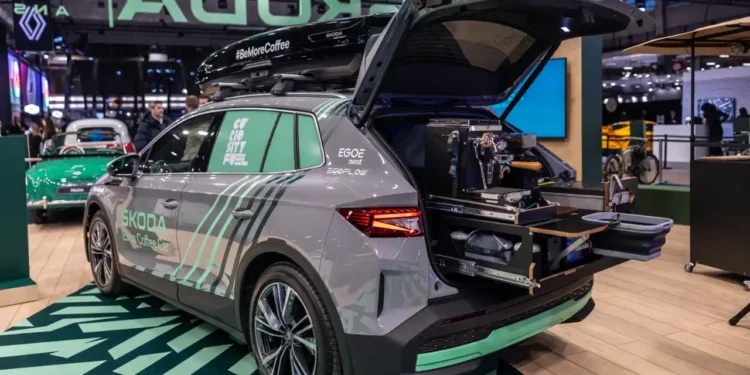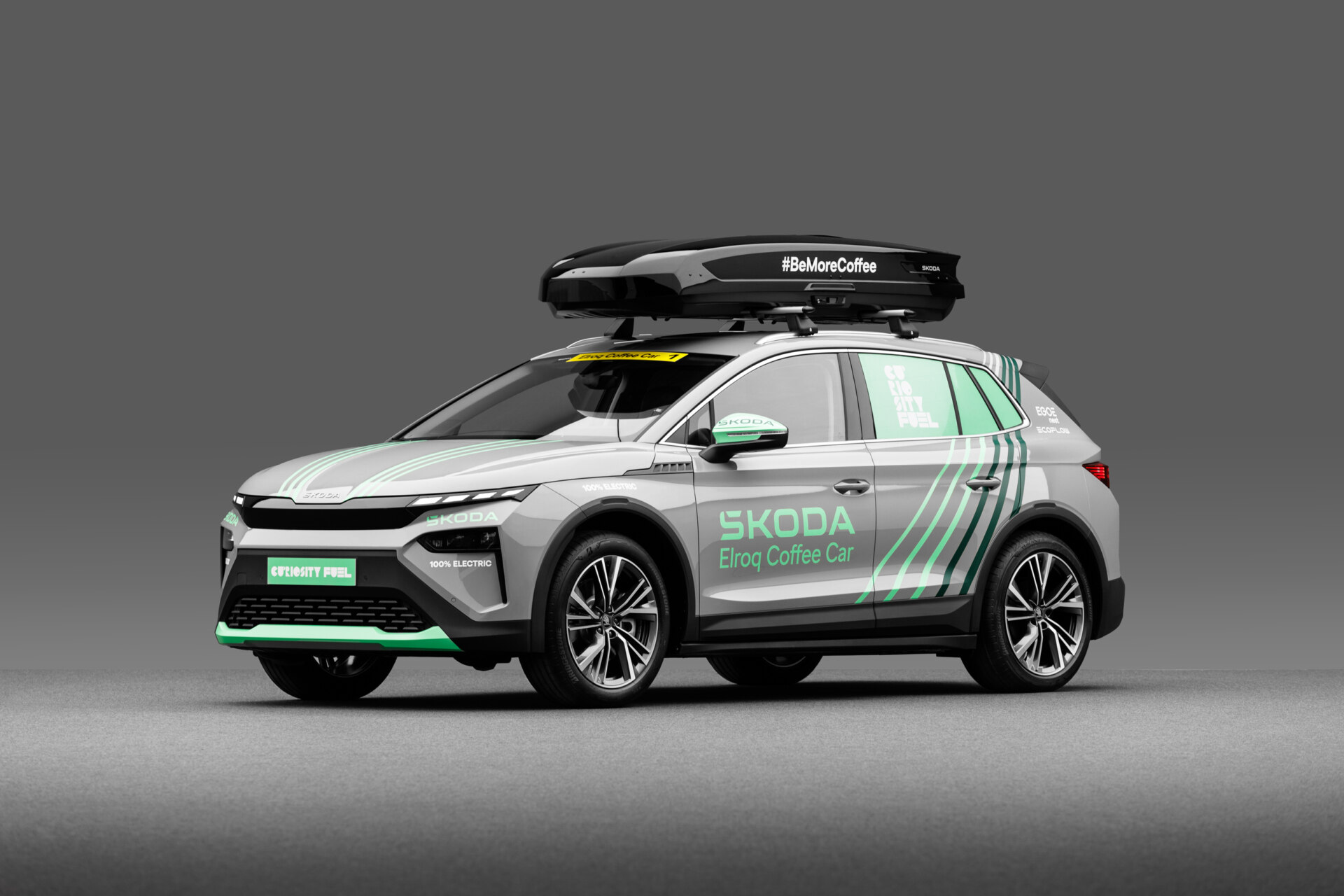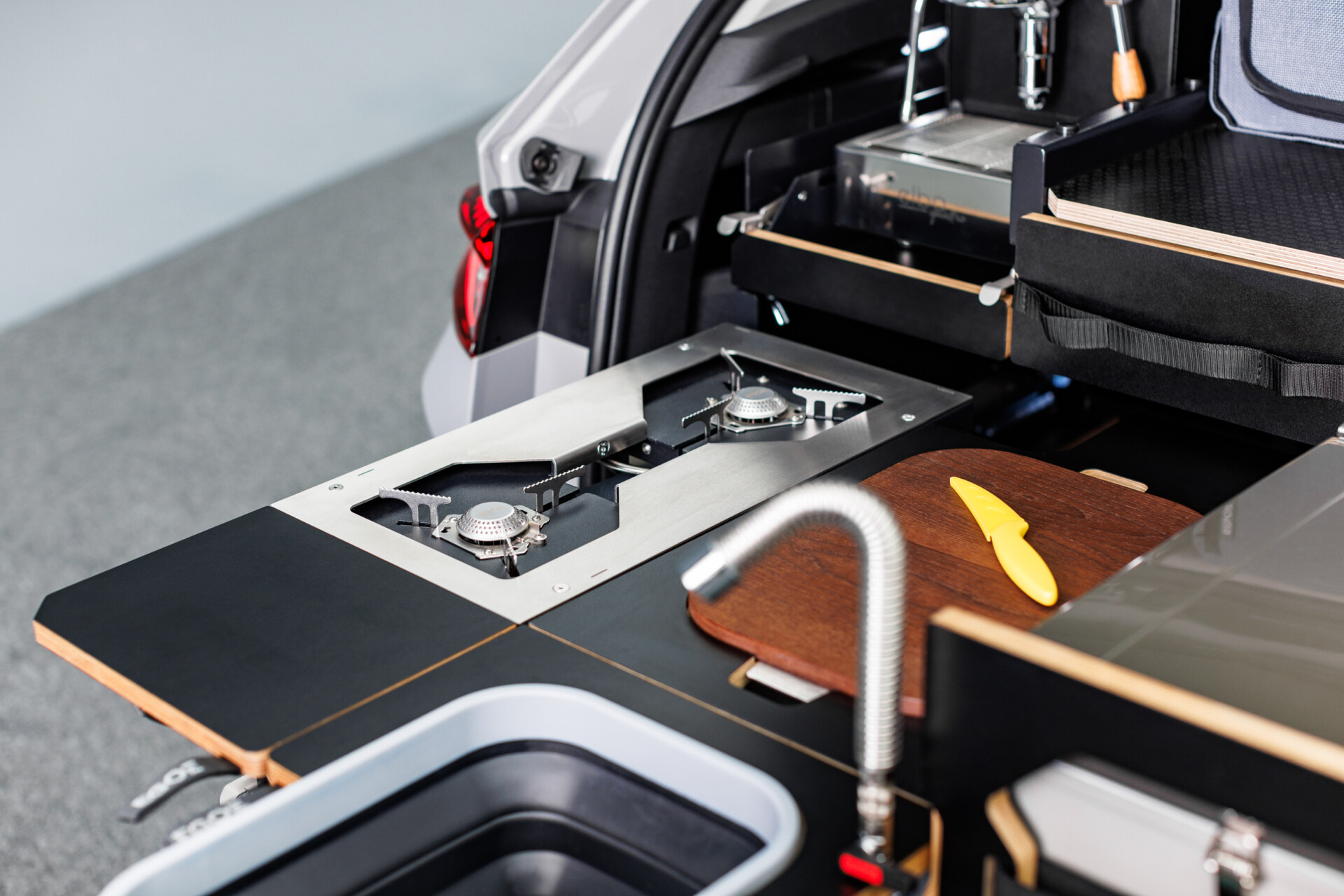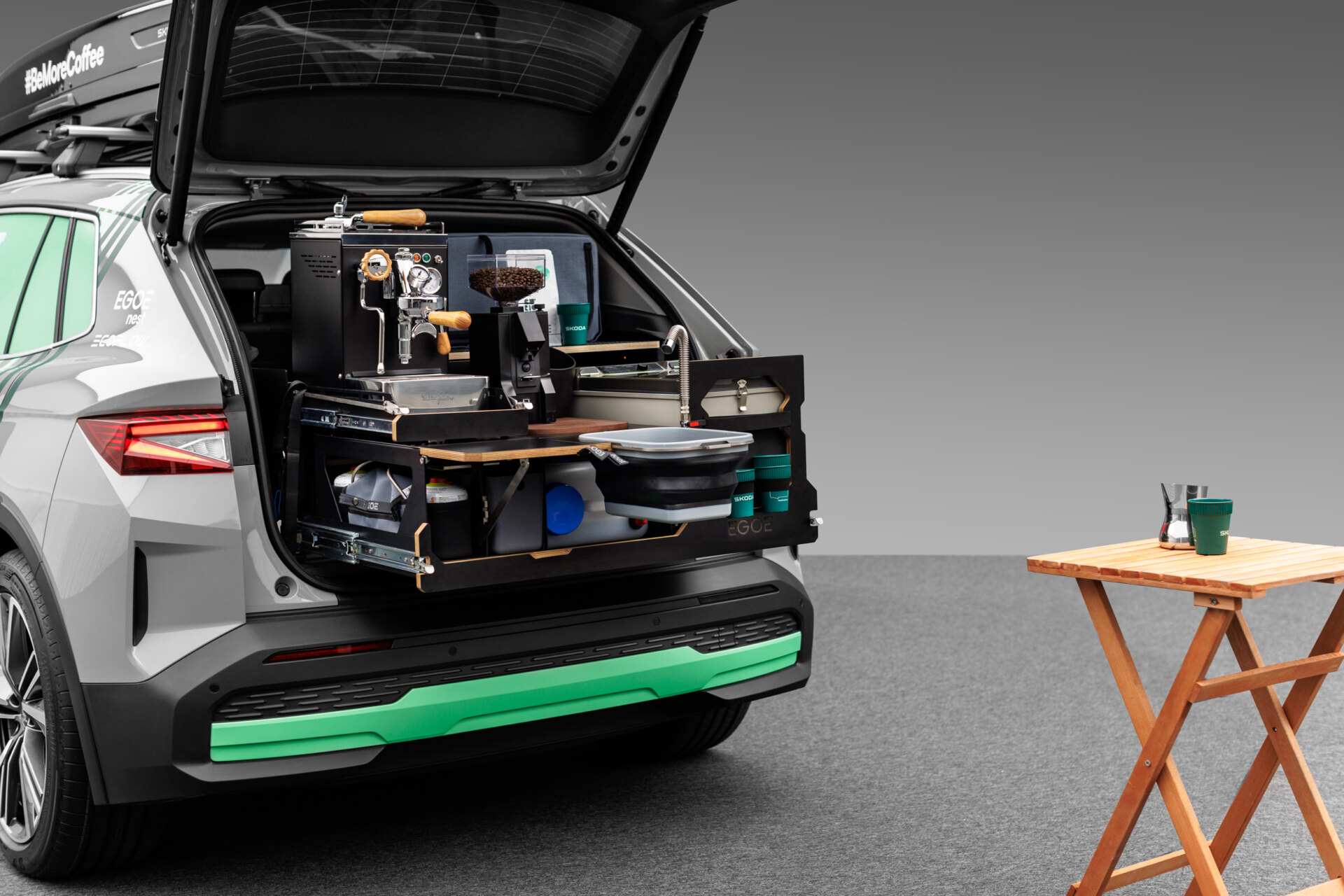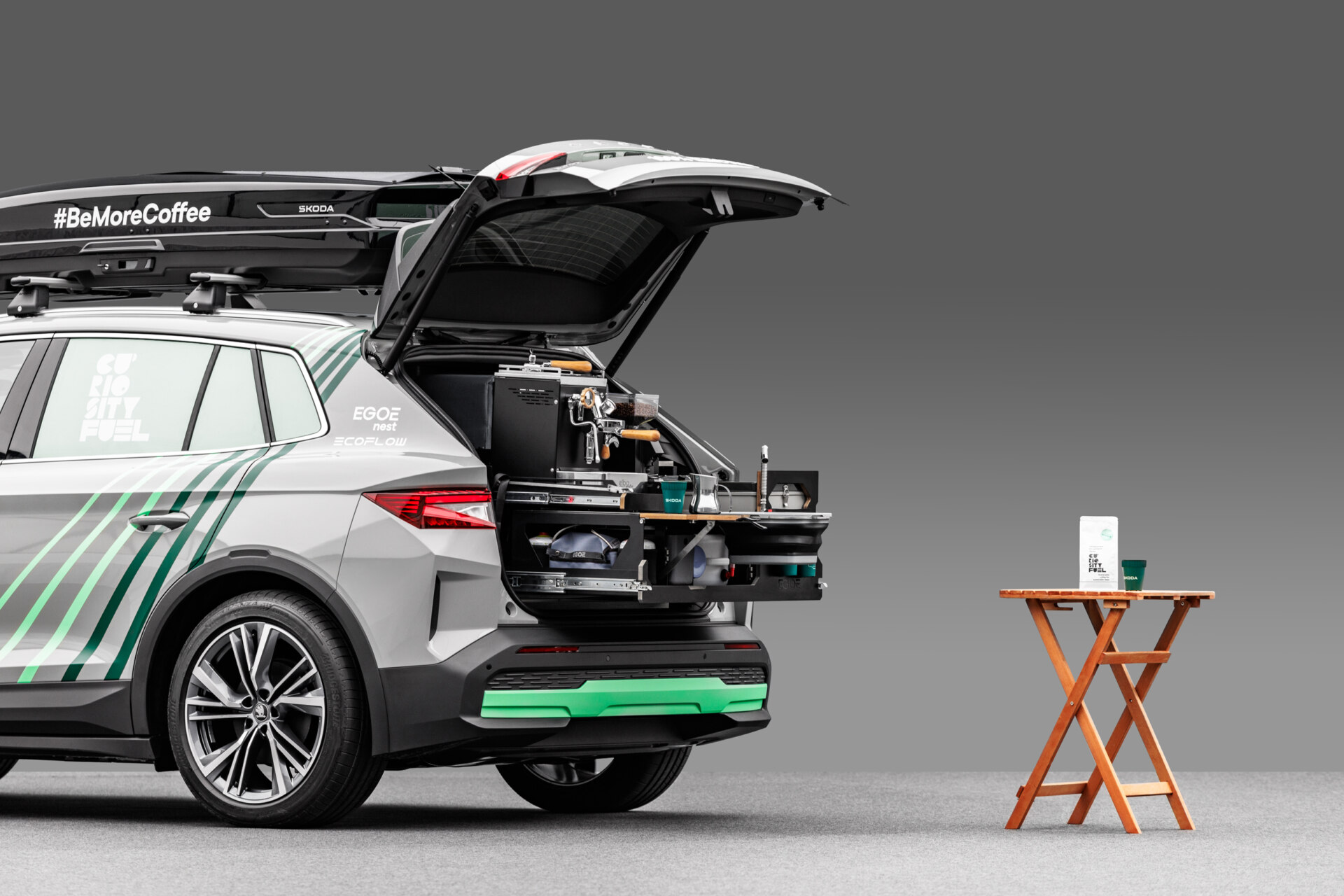How Škoda Turned Electric Cars Into Mobile Coffee Shops: Škoda has taken the idea of vehicle-as-a-service to a delicious extreme. By converting one Elroq and one Enyaq into fully functional Coffee Cars, the brand shows how modern EVs can do far more than move people—they can power professional-grade equipment all day, anywhere. From the Tour de France to Milan Design Week, these Coffee Cars have poured 15,000+ cups at the Tour alone with zero tailpipe emissions and minimal setup time.
- Two EVs—Elroq and Enyaq—converted into mobile cafés
- Café hardware runs directly off the traction battery (up to 82 kWh) through an aux high-voltage DC-AC inverter
- 15,000+ cups served at the Tour de France; 3,000+ in one week at Milan Design Week with ~20% charge remaining
- ~10 minutes setup, operated by a three-member crew
- Solar assist: 100 W roof panel + optional 220 W external panel
- Curiosity Fuel coffee (Rainforest Alliance principles); coffee husks repurposed into seat-trim leather
The Idea, How Škoda Turned Electric Cars Into Mobile Coffee Shops: From Press Drive Gimmick to European Tour
What began as a memorable flourish at the Elroq press drives in Mallorca—pulling café-quality espresso from the very EV on test—scaled quickly. Škoda built a second unit on the Enyaq platform, and the duo now tours brand activations, motorsport caravans, classic car shows, music festivals, and cycling championships across Europe.
How It Works: An EV That Powers a Café
At the heart of each Coffee Car is an auxiliary high-voltage DC-AC inverter that converts the EV’s battery power into clean AC for the café kit.
Power architecture (plain English):
- Traction battery (up to 82 kWh) → 2) Inverter + distribution → 3) AC outlets for café equipment
Because EV batteries deliver steady, silent power with no fumes, the café can run off-grid for days. When the event wraps, the car drives to the next venue and fast-charges as needed—no generators, no diesel, no extra permits.
What’s Onboard: A Professional Café in a Car
Core equipment
- Commercial espresso machine and burr grinder
- Two refrigerators (milk and cold beverages)
- Ice maker and electric kettle (tea/Americanos)
- Compact gas stove (aux/backup heat)
Power & sustainability
- 100 W roof-mounted solar panel
- Optional 220 W external panel for longer gigs
- Inverter sized to run all café loads from the traction battery
Logistics
- Storage for beans, water, recycled paper cups
- Two folding bar tables for service
- Three-person crew; ~10 minutes to first pour (most of it is warming the machine)
Real-World Battery Performance
- Milan Design Week: Over 3,000 coffees in a week on battery-only operation; ~20% charge still remaining at teardown
- Tour de France: 15,000+ cups across the event caravan; the Coffee Car’s bold graphics drew crowds at every stop
Big takeaway: An EV’s traction battery isn’t just “range”—it’s a mobile power plant capable of running commercial operations for days.
Where They’ve Served (So Far)
- Tour de France
- Milan Design Week
- Salon Rétromobile (Paris)
- Metronome Festival (Prague)
- UCI Mountain Bike World Championships (Switzerland)
- Škoda product events (e.g., student-built L&K 130 unveiling, Elroq/Enyaq media drives)
2025 tally: 500+ kg of coffee already ground; tracking to ~1 tonne by year-end.
The Coffee: Curiosity Fuel (Sustainability, Taste, Traceability)
Škoda’s Curiosity Fuel is served at company sites and brand events. Beans come from family farms in India and Tanzania under Rainforest Alliance principles, roasted locally by a Czech family roastery. Even the coffee cherry husks are repurposed into leather for selected Škoda seats—a neat loop from bean to interior.
Why EVs Make Sense for Pop-Up Businesses
- Zero tailpipe emissions and quiet operation—ideal where generators aren’t welcome
- High-capacity, stable power for professional gear
- Rapid redeployment: pack up, drive, DC fast-charge, repeat
- Lower operating costs vs diesel generators; simpler compliance at events
Beyond coffee: food trucks, mobile clinics, emergency response, site offices, retail kiosks, festival booths, remote work pods—generator-free mobile commerce becomes practical.
Marketing Innovation… and a Blueprint for Mobile Commerce
The Coffee Cars aren’t just eye-catching promos—they’re a proof-of-concept for battery-powered operations at scale:
- EV batteries can support multi-day commercial duty cycles
- Pro equipment can run reliably from automotive HV systems
- Existing public charging supports logistics between gigs
- Consumers respond positively to quiet, emission-free service
Technical Specifications
Škoda Elroq Coffee Car
| Item | Value |
|---|---|
| Battery capacity | Up to 82 kWh |
| WLTP combined consumption | 15.2–17.4 kWh/100 km |
| CO₂ emissions (tailpipe) | 0 g/km |
| Solar assist | 100 W roof + 220 W external (opt.) |
| Setup time | ~10 minutes |
| Crew requirement | 3 people |
Škoda Enyaq Coffee Car
| Item | Value |
|---|---|
| Battery capacity | Up to 82 kWh |
| WLTP combined consumption | 14.9–17.0 kWh/100 km |
| CO₂ emissions (tailpipe) | 0 g/km |
| Solar assist | 100 W roof + 220 W external (opt.) |
| Setup time | ~10 minutes |
| Crew requirement | 3 people |
Values vary by vehicle specification and market.
Motors77 Verdict
★★★★★ (5/5)
Škoda’s Coffee Cars prove that EVs can be mobile infrastructure—clean, quiet, powerful and practical. It’s smart marketing that doubles as a commercial blueprint for generator-free pop-ups. If this is what the future of electric mobility tastes like, we’re in. ☕⚡

